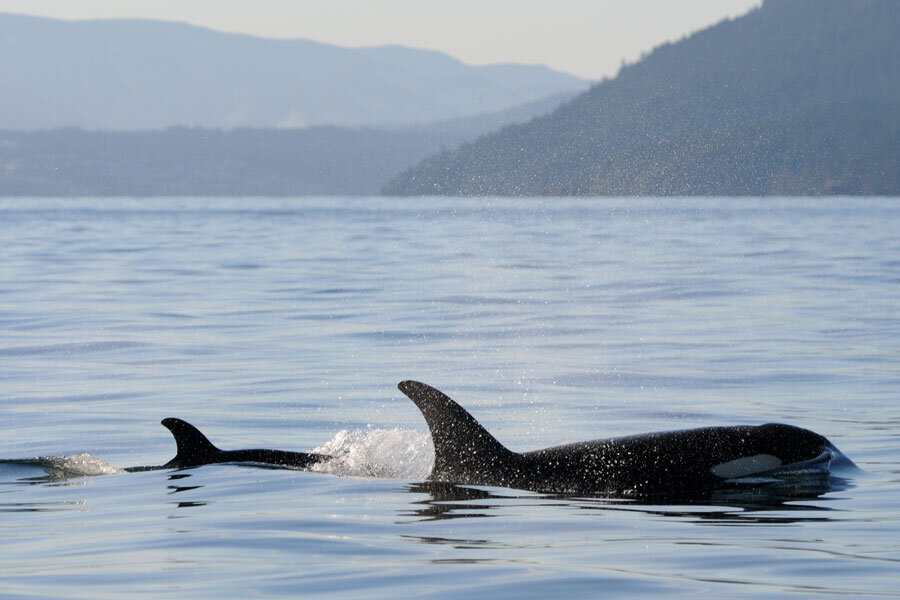Ship noise linked to orca whale decline: Are some boats safer than others?
Loading...
Ship noise in coastal habitats prevents endangered orcas from locating their prey, marine scientists conclude in a PeerJ article published Tuesday.
It’s well known that commercial shipping raises the intensity of low-frequency noise underwater, interfering with the communication and feeding patterns of baleen whales such as the blue, humpback, and North Atlantic right whale species. In one case study, ship noise reduced foraging efficiency by 50 percent in Curvier's beaked whales.
But a new study published Thursday suggests that ships raise underwater noise levels at medium and higher frequencies as well, affecting the frequency range (from 10 Hz to 40,000 Hz) used by endangered southern resident killer whales (SRKW), including at 20,000 Hz where orcas hear best.
Orcas are odontocetes, or toothed whales, and they use echolocation to locate their main food source of salmon. The Haro Strait off of Washington is a critical habitat for the endangered SRKWs, with a population measuring around 88 individuals. But the strait is also a popular Pacific shipping channel, witnessing around 20 ships passing through each day.
“Such ship noise has the potential to mask odontocete signals, especially in coastal environments where shipping lanes are close enough to the shoreline (<10 km) that high frequency sound is not fully absorbed,” the authors explain in their study. “In the summertime habitat of the endangered SRKWs, ship noise may interfere not only with SRKW communication (vocalizations) but also foraging and navigation (echolocation clicks).”
The noise pollution is especially concerning, however, because it compounds an already prevalent food shortage for orcas.
“In an environment where SRKWs may already be food-stressed due to reduced populations of their primary prey – Chinook salmon – echolocation masking could have grave population-level consequences,” the authors explain in their study. “The potential impacts of ship noise on foraging efficiency may be compounded by simultaneous masking of communication calls, some of which may help coordinate foraging on prey sharing.”
And while Tuesday’s study realizes ships’ damaging effects on orcas, the authors offer potential mitigation strategies.
Unlike other studies, the authors studied multiple classes of ships to decipher which produced the most damaging noise pollution. Container ships proved to be the most harmful with the highest med-frequency levels. But military vessels had some of the lowest levels of relevant noise pollution “suggesting that transfer of quieting technology to the commercial sector could be a successful noise mitigation strategy,” according to a press release.
Most importantly, the authors suggest a linear relationship exists between received frequency level and the speed of the ship.
“This suggests a potential mitigation strategy for the average ship – slowing down – that has been recommended previously as an operational ship quieting option,” say the authors. “The strategy has other environmental benefits, like reducing collision risks, and is consistent with recent industry efforts to increase fuel efficiency.”
In a December study published in the journal Plos One, a number of prominent marine biologists and scientists similarly evaluated the relationship between ship noise and killer whales. And after creating research models that examine a number of factors such as ship length, number of propellers and vessel speed, the scientists also concluded that vessel speed was “the most important predictor of noise levels received by whales.” Only measures to reduce vessel speed in killer whale habitats would meaningfully reduce subsequent noise exposure, suggest the authors.
Currently, management regulations only limit the distance between ships and endangered SRKW populations. In 2011, NOAA Fisheries Service adopted distance guidelines under the Marine Mammal Protection Act and Endangered Species Act to protect killer whales in the waters off of Washington. Under the 2011 regulations, it is illegal to position a vessel in the path of oncoming whales within 400 yards and a distance of 200 yards must be upheld at all times.
And there are voluntary guidelines to limit ship speed to less than seven knots, but no legal restrictions. Any reduction would be helpful to the endangered orcas because the data suggests that each reduction in speed by one knot can reduce noise levels by one decibel.
Managers should assess the effectiveness of current regulations, the authors suggest, and decide if other characteristics like vessel speed should be regulated for the health of endangered killer whale populations.






